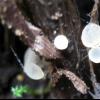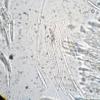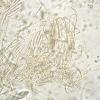
24-12-2025 17:08
Hulda Caroline HolteHello, I have found this propoloid ascomycete on

21-12-2025 09:32
Hello.A tiny ascomycete found embedded in wood in

21-12-2025 21:32
Pol DebaenstHello, Garden, Burgweg 19, Veurne, BelgiumOn 10/1

22-12-2025 23:38
Patrice TANCHAUDBonsoir, récolte sur un mur en pierre, apothéci

22-12-2025 00:47
Patrice TANCHAUDBonsoir, récolte à proximité du milieu dunaire
Gelatinous on Carex
Marja Pennanen,
02-09-2010 10:38
I found these on some Carex yesterday.
They are 1-5mm wide and 3-5 mm high.
Marja Pennanen,
02-09-2010 10:43
Marja Pennanen,
02-09-2010 11:35
Hans-Otto Baral,
02-09-2010 12:13

Re:Gelatinous on Carex
Good find!!
The top cell contains a VB, i.e. a refractive vacuole (like in Mollisia). If you add KOH or MLZ these VBs disappear, also in the herbarium.
This species is Ombrophila pileata (= Hymenoscyphus pileatus). Gel and apical ring tpye clearly exclude Hymenoscyphus, still the current name in IF (although I corrected to Ombrophila already in 1985). The problem is only that in Karsten's type material which I studied is a mixtum: it contains also a very similar species with distinctly smaller and narrower and rather strongly curved spores, O. lacustris. regrettably, Karsten's is not clear in this point, giving +/- both spore types. So I have to select one of them as lectotype.
Zotto
The top cell contains a VB, i.e. a refractive vacuole (like in Mollisia). If you add KOH or MLZ these VBs disappear, also in the herbarium.
This species is Ombrophila pileata (= Hymenoscyphus pileatus). Gel and apical ring tpye clearly exclude Hymenoscyphus, still the current name in IF (although I corrected to Ombrophila already in 1985). The problem is only that in Karsten's type material which I studied is a mixtum: it contains also a very similar species with distinctly smaller and narrower and rather strongly curved spores, O. lacustris. regrettably, Karsten's is not clear in this point, giving +/- both spore types. So I have to select one of them as lectotype.
Zotto
Marja Pennanen,
02-09-2010 12:23
Re:Gelatinous on Carex
Thank you for det. and explanations :)
Marja
Marja


